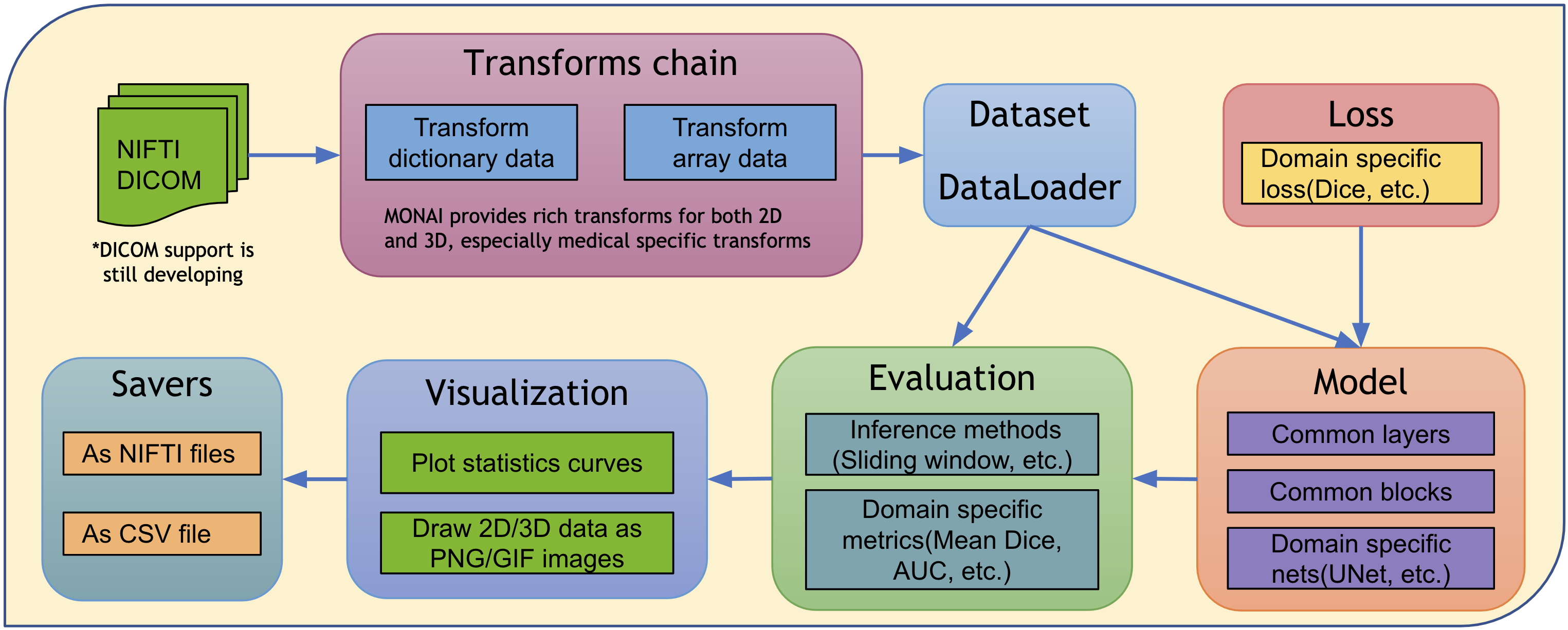Modules for public alpha¶
MONAI aims at supporting deep learning in medical image analysis at multiple granularities.
This figure shows modules currently available in the codebase.
 The rest of this page provides more details for each module.
The rest of this page provides more details for each module.
Medical image data I/O, preprocessing, and augmentation¶
Medical images require highly specialized methods for I/O, preprocessing, and augmentation. Medical images are often in specialized formats with rich meta-information, and the data volumes are often high-dimensional. These require carefully designed manipulation procedures. The medical imaging focus of MONAI is enabled by powerful and flexible image transformations that facilitate user-friendly, reproducible, optimized medical data pre-processing pipelines.
1. Transforms support both Dictionary and Array format data¶
The widely used computer vision packages (such as
torchvision) focus on spatially 2D array image processing. MONAI provides more domain-specific transformations for both spatially 2D and 3D and retains the flexible transformation “compose” feature.As medical image preprocessing often requires additional fine-grained system parameters, MONAI provides transforms for input data encapsulated in python dictionaries. Users are able to specify the keys corresponding to the expected data fields and system parameters to compose complex transformations.
2. Medical specific transforms¶
MONAI aims at providing a rich set of popular medical image specific transformations. These currently include, for example:
LoadNifti: Load Nifti format file from provided pathSpacing: Resample input image into the specifiedpixdimOrientation: Change the image’s orientation into the specifiedaxcodesRandGaussianNoise: Perturb image intensities by adding statistical noisesNormalizeIntensity: Intensity Normalization based on mean and standard deviationAffine: Transform image based on the affine parametersRand2DElastic: Random elastic deformation and affine in 2DRand3DElastic: Random elastic deformation and affine in 3D
3. Fused spatial transforms and GPU acceleration¶
As medical image volumes are usually large (in multi-dimensional arrays), pre-processing performance obviously affects the overall pipeline speed. MONAI provides affine transforms to execute fused spatial operations, supports GPU acceleration via native PyTorch to achieve high performance.
For example:
# create an Affine transform
affine = Affine(
rotate_params=np.pi/4,
scale_params=(1.2, 1.2),
translate_params=(200, 40),
padding_mode='zeros',
device=torch.device('cuda:0')
)
# convert the image using bilinear interpolation
new_img = affine(image, spatial_size=(300, 400), mode='bilinear')
4. Randomly crop out batch images based on positive/negative ratio¶
Medical image data volume may be too large to fit into GPU memory. A widely-used approach is to randomly draw small size data samples during training and run a “sliding window” routine for inference. MONAI currently provides general random sampling strategies including class-balanced fixed ratio sampling which may help stabilize the patch-based training process.
5. Deterministic training for reproducibility¶
Deterministic training support is necessary and important for deep learning research, especially in the medical field. Users can easily set the random seed to all the transforms in MONAI locally and will not affect other non-deterministic modules in the user’s program. For example:
# define a transform chain for pre-processing
train_transforms = monai.transforms.compose.Compose([
LoadNiftid(keys=['image', 'label']),
RandRotate90d(keys=['image', 'label'], prob=0.2, spatial_axes=[0, 2]),
... ...
])
# set determinism for reproducibility
train_transforms.set_random_state(seed=0)
torch.manual_seed(0)
torch.backends.cudnn.deterministic = True
torch.backends.cudnn.benchmark = False
6. Cache IO and transforms data to accelerate training¶
Users often need to train the model with many (potentially thousands of) epochs
over the data to achieve the desired model quality. A native PyTorch
implementation may repeatedly load data and run the same preprocessing steps
for every epoch during training, which can be time-consuming and unnecessary,
especially when the medical image volumes are large.
MONAI provides a caching mechanism to accelerate these transformation steps
during training by storing the intermediate outcomes before the first
randomized transform in the transform chain. Enabling this feature could
potentially give 10x training speedups.

Losses¶
There are domain-specific loss functions in the medical imaging research which are not typically used in the generic computer vision tasks. As an important module of MONAI, these loss functions are implemented in PyTorch, such as Dice loss and generalized Dice loss.
Network architectures¶
Some deep neural network architectures have shown to be particularly effective for medical imaging analysis tasks. MONAI implements reference networks with the aims of both flexibility and code readability. In order to leverage the common network layers and blocks, MONAI provides several predefined layers and blocks which are compatible with 1D, 2D and 3D networks. Users can easily integrate the layer factories in their own networks. For example:
# import MONAI’s layer factory
from monai.networks.layers import Conv
# adds a transposed convolution layer to the network
# which is compatible with different spatial dimensions.
name, dimension = Conv.CONVTRANS, 3
conv_type = Conv[name, dimension]
add_module('conv1', conv_type(in_channels, out_channels, kernel_size=1, bias=False))
Evaluation¶
To run model inferences and evaluate the model quality, MONAI provides reference implementations for the relevant widely-used approaches. Currently, several popular evaluation metrics and inference patterns are included:
1. Sliding window inference¶
For model inferences on large volumes, the sliding window approach is a popular choice to achieve high performance while having flexible memory requirements.
Select continuous windows on the original image.
Iteratively run batched window inferences until all windows are analyzed.
Aggregate the inference outputs to a single segmentation map.
Save the results to file or compute some evaluation metrics.

2. Metrics for medical tasks¶
Various useful evaluation metrics have been used to measure the quality of medical image specific models. MONAI already implemented mean Dice score for segmentation tasks and the area under the ROC curve for classification tasks. We continue to integrate more options.
Visualization¶
Beyond the simple point and curve plotting, MONAI provides intuitive interfaces to visualize multidimensional data as GIF animations in TensorBoard. This could provide a quick qualitative assessment of the model by visualizing, for example, the volumetric inputs, segmentation maps, and intermediate feature maps.
Result writing¶
Currently MONAI supports writing the model outputs as NIfTI files for segmentation tasks, and as CSV files for classification tasks. A rich set of formats will be supported, along with relevant statistics and evaluation metrics automatically computed from the outputs.